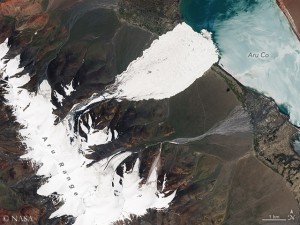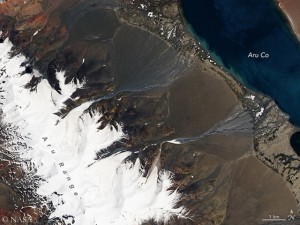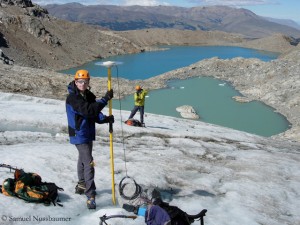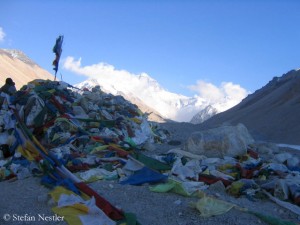Huge ice avalanche in Tibet
This summer a mega ice avalanche has swept down on the Tibetan plateau. In the Aru Range in northwestern Tibet a whole glacier tongue broke off and tumbled down into the valley. Scientists say it was one of the largest ice avalanches ever recorded. According to the Chinese authorities this natural event, which already occurred on 17 July, killed nine Tibetan herders. More than 350 sheep and 110 yaks were buried under the ice and rock masses. The American space agency NASA now published satellite images which show the dimension: The ice covered an area of ten square kilometers, the lake down in the valley was colored white and the debris piled up 30 meters in some places. The cause of the collapse is still unclear. “Climate change is causing more glacial hazards through mechanisms we do not fully understand,” said the Chinese glaciologist Tian Lide. “There is an urgent need for more monitoring and research efforts, especially in populated areas in high mountains.”
I called the Swiss scientist Samuel Nussbaumer. The 35-year-old glaciologist is working for the World Glacier Monitoring Service (WGMS) in Zurich, which is observing and analyzing the fluctuation of glaciers worldwide.
How unusual is this massive ice avalanche in Tibet?
The way I see it, really the complete glacier tongue has broken off, the entire lower part. I don’t know about another event of that extent – but of course we only know about what has been documented. In 2002, there was a case of a similar dimension at the Kolka Glacier in the Russian Caucasus (about 140 people died then). But there had been a rockfall first that carried away the ice. We know pretty well, what happened back then. The exact circumstances in Tibet, however, are not yet known.
Are such massive glacial ice avalanches predictable? Are there alarming hints?
Glaciers are in constant movement. Signs are for example the crevasses which can be observed with cameras or high-resolution satellite images. Doing this, such an event could be foreseen. But of course it is not practical to monitor all glaciers worldwide. In the Alps many glaciers are observed. The dimension, however, is much smaller. There are e.g. steep hanging glaciers, where parts are in danger of breaking off and impacting on villages or cable car stations. These glaciers are monitored by automatic cameras. Such glacial collapses can be predicted – e.g. when the ice is flowing faster or the crevasses are getting larger.
Are huge ice avalanches like in Tibet a result of climate change?
You can’t make a statement about it as long as the cause of the event in Tibet is not yet finally clarified. But melt water plays an important role in the process of a sliding glacier tongue. In 1965 we had such an event on the Allalin glacier in Switzerland (88 people died), where the complete glacier tongue broke away too. In these cases there is often plenty of water in the glacier bed on which the ice can slide, and then suddenly it breaks. It’s a well-known phenomenon in steep glaciers, but of course in a much smaller extent than now in Tibet. If the temperatures are higher, the chance is greater that there is more meltwater and that the water on the surface acts like a lubricant.










